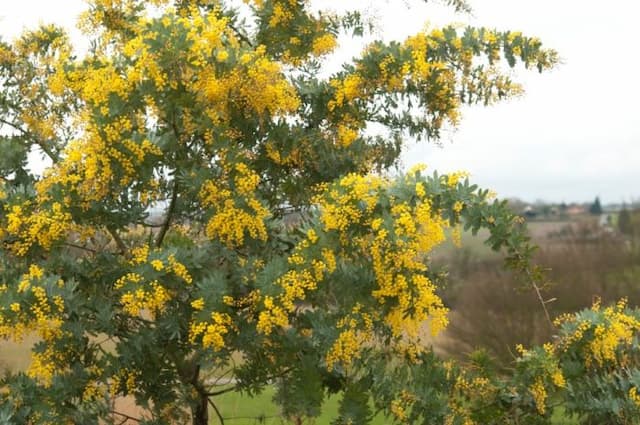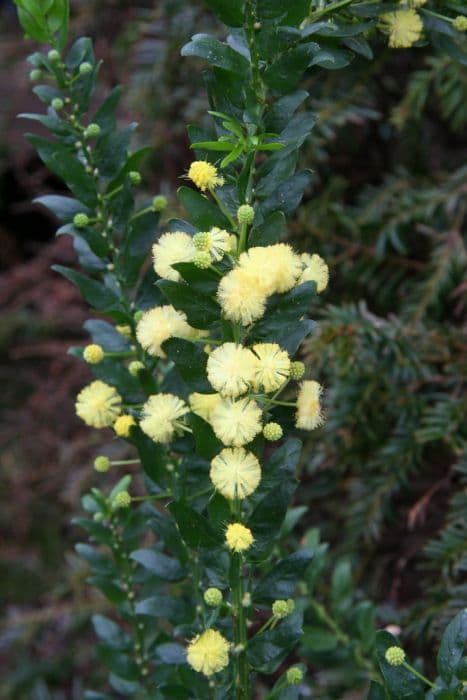Wirilda Acacia retinodes

ABOUT
Acacia retinodes, commonly known as the water wattle, is a perennial plant characterized by its striking and distinctive appearance. This plant typically blossoms with bright yellow flowers arranged in spherical clusters, which add a vibrant splash of color to the greenery. The flowers are notable for their small size and delicate texture, giving the plant a soft, inviting aesthetic. The foliage of the water wattle consists of slender, willow-like leaves that are elongated and somewhat lance-shaped. These leaves are often a bright green, adding a fine texture and a graceful, weeping form to the plant’s overall look. The elongation of the leaves creates a gentle contrast to the fluffy, rounded flower clusters. The stems and branches of the water wattle are slightly angular and may have a reddish tinge, which can be particularly noticeable in the newer growth. As the plant matures, the bark becomes more textured, providing an interesting visual and tactile quality to the plant. Overall, the appearance of the water wattle is one that evokes a sense of elegance and lightness, with its willowy leaves and cheerful floral displays creating an attractive sight in any setting where it is grown.
About this plant
 Names
NamesFamily
Fabaceae.
Synonyms
Wirilda, Water Wattle, Swamp Wattle, Silver Wattle, Retinodes Water Wattle.
Common names
Acacia retinodes var. uncifolia, Racosperma retinodes, Acacia retinodes var. retinodes, Acacia retinodes var. grandis, Acacia retinodes var. normalis, Acacia retinodes subsp. uncifolia.
 Toxicity
ToxicityTo humans
Acacia retinodes, commonly known as Wirilda, is not widely recognized for its toxicity to humans. There is limited information on specific toxic properties for human ingestion. However, as with many plants, individual parts may contain compounds that could potentially cause adverse reactions if consumed in large amounts. It is generally advisable to avoid eating or using any part of ornamental plants for medicinal purposes without proper expertise and guidance.
To pets
Wirilda, as Acacia retinodes is more commonly known, is not typically listed as a toxic plant to domestic pets like cats and dogs. However, as with all plants, there may be some risk of indigestion or allergic reactions, particularly if a pet consumes a large quantity of the plant. If you suspect your pet has ingested parts of the Wirilda and is showing symptoms such as vomiting, diarrhea, or abnormal behavior, it is recommended to consult a veterinarian.
 Characteristics
CharacteristicsLife cycle
Perennials
Foliage type
Evergreen
Color of leaves
Green
Flower color
Yellow
Height
20-30 ft (6-9 m)
Spread
15-20 ft (4.5-6 m)
Plant type
Tree
Hardiness zones
9
Native area
Australia
Benefits
 General Benefits
General Benefits- Erosion control - Acacia retinodes has a robust root system that helps stabilize soil and prevent erosion.
- Wildlife Habitat - It provides shelter and food for various bird species, insects, and small mammals.
- Nitrogen fixation - This species can convert atmospheric nitrogen into a form useable by plants, enriching soil fertility.
- Ornamental use - With its bright yellow flowers, it is often used in gardens and landscaping for aesthetic purposes.
- Windbreak - It can act as a barrier against strong winds, protecting crops and soil.
- Timber production - The wood from Acacia retinodes is used for furniture, crafts, and fuel.
- Hedging and screening - It can be pruned into hedges or used as a natural screen for privacy.
- Tannin production - The bark contains tannins that can be extracted and used in the leather industry.
- Shade provider - The canopy offers shade, which can be beneficial in hot climates and for underplanting with less sun-tolerant species.
- Revegetation - The plant is useful for revegetation projects due to its adaptability and hardiness.
 Medical Properties
Medical Properties- This plant is not used for medical purposes.
 Air-purifying Qualities
Air-purifying QualitiesThis plant is not specifically known for air purifying qualities.
 Other Uses
Other Uses- Acacia retinodes, also known as Wirilda, can be used in the production of perfumes due to its fragrant flowers which yield a sweet aroma.
- The timber of Wirilda can be harvested for fine woodworking as it can provide an attractive finish for furniture and cabinetry.
- The bark of the Wirilda tree has been utilized traditionally for tanning leather due to the presence of tannins.
- Wirilda's dried pods are sometimes used in decorative arrangements or as a component in floral crafts.
- The tree can act as a windbreak or hedging plant on farms, providing shelter for crops or livestock.
- Wirilda's extensive root system can be used for erosion control because it helps stabilize soil on slopes and riverbanks.
- Due to its hardiness and attractive foliage, Wirilda can be employed in xeriscaping, requiring minimal water landscapes.
- The species can be utilized in reclaiming sites with saline soil, as it has a high salt tolerance which makes it suitable for such environments.
- Wirilda seeds are employed in educational settings for teaching about plant growth and botany due to their relatively easy germination.
- In agroforestry systems, Wirilda is sometimes interplanted with crops as a "nurse tree" providing shade and enhancing soil conditions.
Interesting Facts
 Feng Shui
Feng ShuiThe Acacia retinodes, commonly known as the Wirilda, is not used in Feng Shui practice.
 Zodiac Sign Compitability
Zodiac Sign CompitabilityThe Wirilda is not used in astrology practice.
 Plant Symbolism
Plant Symbolism- Resilience and Endurance: Acacia retinodes, commonly known as Wirilda, showcases remarkable resilience and adaptation to harsh environments, symbolizing the human capacity to endure challenges and thrive.
- Eternal and Unbreakable Friendships: The Wirilda's sturdy nature represents the strong bonds of friendship that last a lifetime and remain steadfast through adversity.
- Purity and Innocence: Traditionally, acacia species have been associated with purity and innocence due to their delicate flowers and graceful appearance.
 Water
WaterThe Wirilda (Acacia retinodes) thrives when its soil is kept moderately moist, especially during its young stage or growing season. It's important to water the Wirilda deeply, allowing water to reach the root zone. An estimated 1 to 2 gallons of water per week is suitable, depending on the weather conditions. During hot, dry spells, increase the frequency to twice a week, while in cooler or rainy periods, you can reduce watering to once every two weeks. Ensure the soil has good drainage, as Acacia retinodes does not tolerate waterlogged conditions.
 Light
LightWirilda prefers full sun conditions, thriving best with at least 6 to 8 hours of direct sunlight per day. It is ideally positioned in a spot where it receives unfiltered sunlight for the majority of the day. However, it can also tolerate partial shade, especially in the hottest parts of its range. Ensure that the plant is not overshadowed by taller vegetation or structures that could limit its light exposure.
 Temperature
TemperatureThe Wirilda is adapted to a wide range of temperatures but ideally prefers environments where the temperature ranges between 30°F to 90°F. It can withstand occasional dips down to about 20°F but is not frost-tolerant for extended periods. For optimal growth, maintaining an environment that doesn't frequently drop below the freezing point is ideal.
 Pruning
PruningPruning the Wirilda helps maintain its shape, encourages bushier growth, and removes any dead or damaged branches. Pruning should be done in late winter or early spring before new growth begins. This timing allows the plant to heal quickly and put its energy into the new growth. Typically, light pruning once a year is sufficient.
 Cleaning
CleaningAs needed
 Soil
SoilWirilda thrives in well-draining soil with a slight acidity to neutral pH, ideally between 6.0 and 7.5. A mix containing sand, loam, and compost is beneficial for its growth. It is important to ensure that the soil allows for good drainage to prevent root rot, while providing enough organic matter for nutrient retention.
 Repotting
RepottingWirilda generally does not require frequent repotting as it appreciates having room for its roots to establish. Repotting every two to three years is sufficient, or when it becomes root-bound. It is essential to use a fresh soil mix that maintains good drainage.
 Humidity & Misting
Humidity & MistingWirilda prefers a dry to moderate humidity environment and is well-suited to the arid conditions of its native habitat. It does not thrive in high humidity settings, making it suitable for typical indoor humidity levels.
 Suitable locations
Suitable locationsIndoor
Ensure bright light, and avoid overwatering.
Outdoor
Plant in full sun, protect from severe frosts.
Hardiness zone
9-11 USDA
 Life cycle
Life cycleAcacia retinodes, commonly known as the Wirilda, begin their life cycle with seed germination, typically after a fire or mechanical scarification breaks their seed dormancy. The seedlings establish a root system and grow into saplings, featuring compound leaves called phyllodes. As the Wirilda matures, it develops into a shrub or small tree, capable of flowering throughout the year with yellow, rod-shaped flower clusters that are attractive to pollinators. Following pollination, the plant produces elongated seed pods that eventually dry and release seeds. These seeds re-enter a state of dormancy until conditions are favorable for germination. The Wirilda is able to regenerate after bushfires by resprouting from its lignotuber or from epicormic buds along the trunk and branches.
 Propogation
PropogationPropogation time
Spring to Summer
Acacia retinodes, commonly known as the Wirilda, can be propagated by seeds, which is the most popular method. Seeds of Wirilda typically have a hard outer coating, which is an evolutionary adaptation to prevent germination until conditions are ideal. To propagate Wirilda seeds, it is necessary to first treat them with a method to break their dormancy, a process known as scarification. Scarification can be done mechanically by nicking or sanding the seed coat or by soaking the seeds in hot water (just off the boil) and leaving them to soak as the water cools for several hours or overnight. Once treated, the seeds are sown in well-draining soil mix, kept moist, and placed in a warm, sunny location to encourage germination. Seedlings are then grown on until they are large enough to handle and plant out. Seed propagation is often carried out in late winter to early spring to align with the beginning of the growing season.









